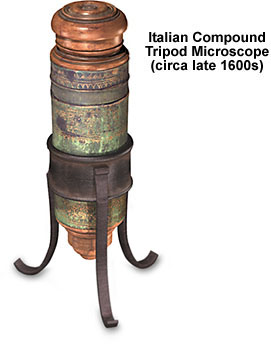Seventeenth Century
Italian Tripod Microscope
This elegant seventh-century tripod microscope is part of the collection of the Institute and Museum of the History of Science in Florence, Italy. Gerard Turner has described the construction and history of this microscope in fine detail.

The microscope body is constructed of pasteboard, leather, and wood, and supported by a crude cast iron collar suspended by a trio of iron legs. Both the inner and outer body tubes are composed of pasteboard covered in green vellum with elaborate gold tooling decorating the outer tube. Marker lines on the inner tube indicate the maximum and minimum extensions of this tube with respect to the upper end of the outer tube. The eyepiece and nosepiece are fabricated with stained sycamore wood. Lens design is consistent throughout the microscope with both the objective and field lens being bi-concave and of similar construction. The eye lens is also bi-concave, but is hampered by inclusion of many small air bubbles left as residuals from the annealing process. Originally, the microscope design and construction was attributed to Galileo, but later studies indicate that the most probable designer was Giuseppe Campani of Rome.
BACK TO SIXTEENTH-SEVENTEENTH CENTURY MICROSCOPES
